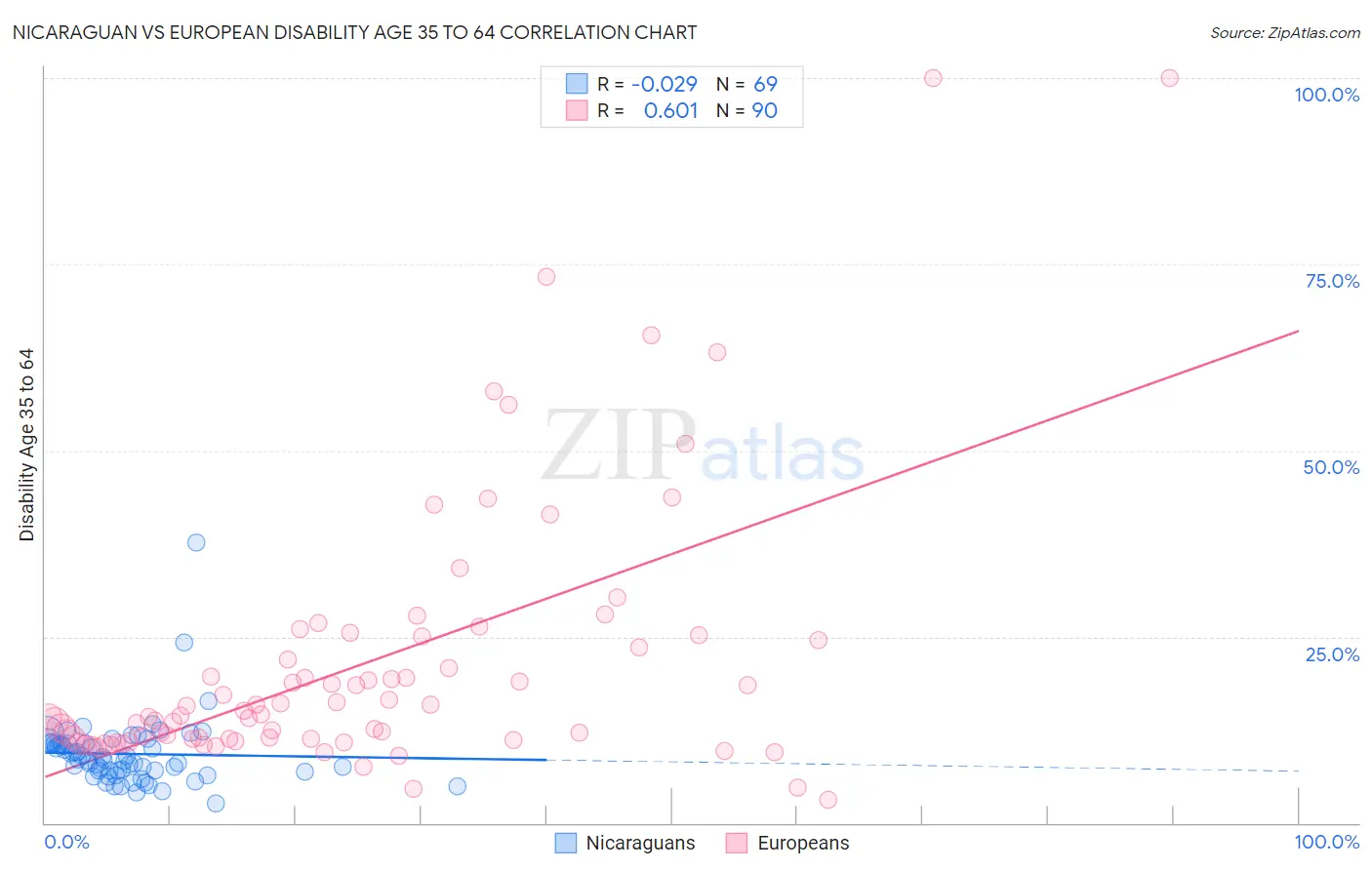Nicaraguan vs European Disability Age 35 to 64
COMPARE
Nicaraguan
European
Disability Age 35 to 64
Disability Age 35 to 64 Comparison
Nicaraguans
Europeans
10.2%
DISABILITY AGE 35 TO 64
99.1/ 100
METRIC RATING
87th/ 347
METRIC RANK
11.7%
DISABILITY AGE 35 TO 64
13.5/ 100
METRIC RATING
209th/ 347
METRIC RANK
Nicaraguan vs European Disability Age 35 to 64 Correlation Chart
The statistical analysis conducted on geographies consisting of 285,605,152 people shows no correlation between the proportion of Nicaraguans and percentage of population with a disability between the ages 34 and 64 in the United States with a correlation coefficient (R) of -0.029 and weighted average of 10.2%. Similarly, the statistical analysis conducted on geographies consisting of 560,896,486 people shows a significant positive correlation between the proportion of Europeans and percentage of population with a disability between the ages 34 and 64 in the United States with a correlation coefficient (R) of 0.601 and weighted average of 11.7%, a difference of 14.5%.

Disability Age 35 to 64 Correlation Summary
| Measurement | Nicaraguan | European |
| Minimum | 2.6% | 3.2% |
| Maximum | 37.6% | 100.0% |
| Range | 35.0% | 96.8% |
| Mean | 9.3% | 21.5% |
| Median | 8.5% | 14.5% |
| Interquartile 25% (IQ1) | 6.9% | 11.2% |
| Interquartile 75% (IQ3) | 10.7% | 24.6% |
| Interquartile Range (IQR) | 3.8% | 13.4% |
| Standard Deviation (Sample) | 4.7% | 18.3% |
| Standard Deviation (Population) | 4.7% | 18.2% |
Similar Demographics by Disability Age 35 to 64
Demographics Similar to Nicaraguans by Disability Age 35 to 64
In terms of disability age 35 to 64, the demographic groups most similar to Nicaraguans are Immigrants from Europe (10.2%, a difference of 0.0%), Immigrants from Kuwait (10.2%, a difference of 0.080%), Chilean (10.2%, a difference of 0.23%), Uruguayan (10.2%, a difference of 0.25%), and Sri Lankan (10.2%, a difference of 0.29%).
| Demographics | Rating | Rank | Disability Age 35 to 64 |
| Immigrants | Croatia | 99.3 /100 | #80 | Exceptional 10.2% |
| Latvians | 99.2 /100 | #81 | Exceptional 10.2% |
| Russians | 99.2 /100 | #82 | Exceptional 10.2% |
| Immigrants | Brazil | 99.2 /100 | #83 | Exceptional 10.2% |
| Sri Lankans | 99.2 /100 | #84 | Exceptional 10.2% |
| Immigrants | Kuwait | 99.1 /100 | #85 | Exceptional 10.2% |
| Immigrants | Europe | 99.1 /100 | #86 | Exceptional 10.2% |
| Nicaraguans | 99.1 /100 | #87 | Exceptional 10.2% |
| Chileans | 99.0 /100 | #88 | Exceptional 10.2% |
| Uruguayans | 99.0 /100 | #89 | Exceptional 10.2% |
| Afghans | 98.9 /100 | #90 | Exceptional 10.3% |
| Immigrants | Lebanon | 98.9 /100 | #91 | Exceptional 10.3% |
| Immigrants | Northern Africa | 98.7 /100 | #92 | Exceptional 10.3% |
| Immigrants | North Macedonia | 98.7 /100 | #93 | Exceptional 10.3% |
| Immigrants | Italy | 98.7 /100 | #94 | Exceptional 10.3% |
Demographics Similar to Europeans by Disability Age 35 to 64
In terms of disability age 35 to 64, the demographic groups most similar to Europeans are Belgian (11.7%, a difference of 0.070%), Canadian (11.7%, a difference of 0.080%), Guatemalan (11.7%, a difference of 0.19%), Native Hawaiian (11.7%, a difference of 0.22%), and Ghanaian (11.7%, a difference of 0.22%).
| Demographics | Rating | Rank | Disability Age 35 to 64 |
| Immigrants | Guatemala | 17.5 /100 | #202 | Poor 11.6% |
| British | 17.0 /100 | #203 | Poor 11.6% |
| Nigerians | 16.3 /100 | #204 | Poor 11.6% |
| Slavs | 15.5 /100 | #205 | Poor 11.7% |
| Native Hawaiians | 14.8 /100 | #206 | Poor 11.7% |
| Ghanaians | 14.8 /100 | #207 | Poor 11.7% |
| Guatemalans | 14.6 /100 | #208 | Poor 11.7% |
| Europeans | 13.5 /100 | #209 | Poor 11.7% |
| Belgians | 13.1 /100 | #210 | Poor 11.7% |
| Canadians | 13.0 /100 | #211 | Poor 11.7% |
| Immigrants | Jamaica | 11.8 /100 | #212 | Poor 11.7% |
| Yugoslavians | 11.6 /100 | #213 | Poor 11.7% |
| Immigrants | Sudan | 11.4 /100 | #214 | Poor 11.7% |
| Spanish American Indians | 11.1 /100 | #215 | Poor 11.7% |
| Bahamians | 10.7 /100 | #216 | Poor 11.8% |